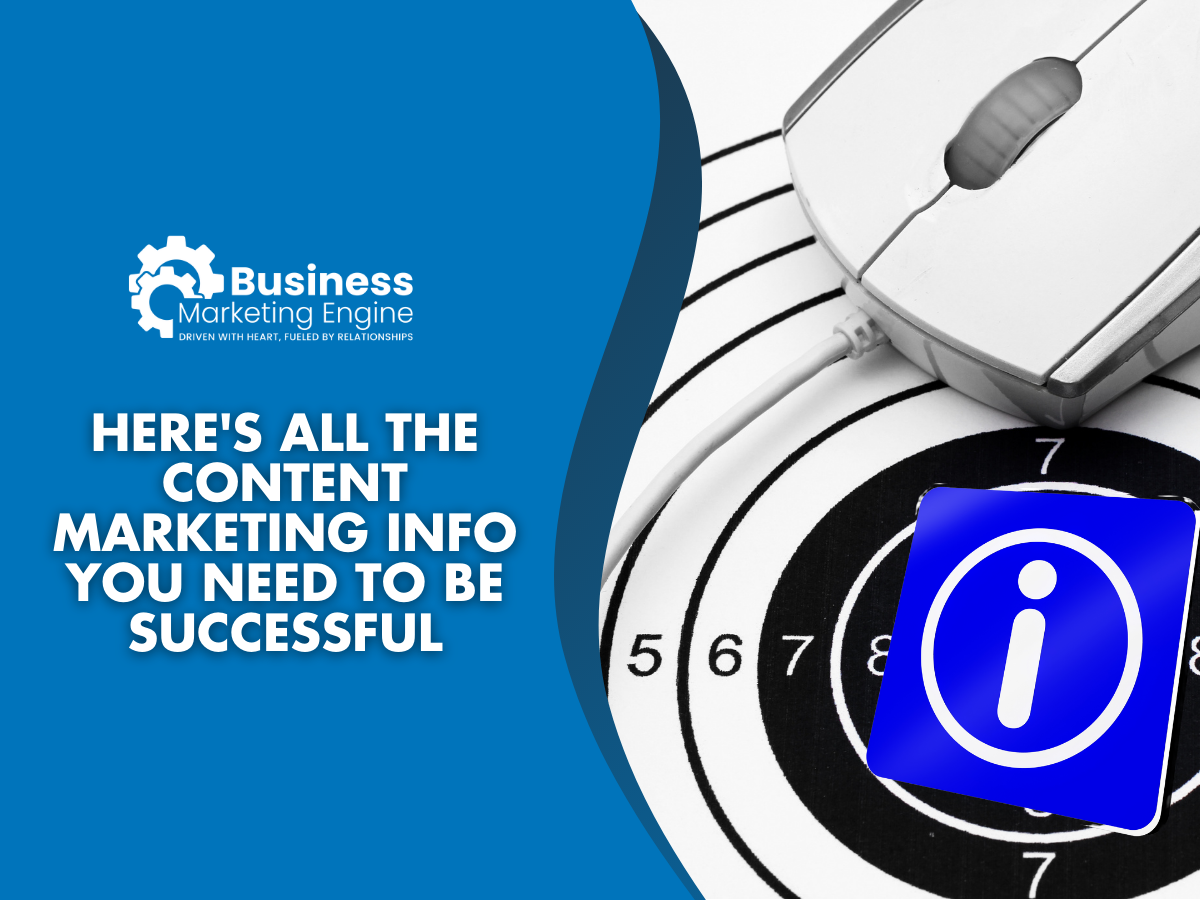Believe me, content marketing isn’t as difficult or as time-consuming as it sounds. In fact, once you get the hang of it, content marketing can be a breeze.
You’ve got the value of your products and/or services wrapped up in a nice pretty package, now you just need the right people to see it. That’s where content marketing comes in.
Unfortunately, many businesses big and small struggle with content marketing because they don’t know where to start, or they try to do too much at once.
There are many different avenues you can take with content marketing, so it can be tricky to know which methods are right for you.
If you’re just getting started with content marketing, or if you’re looking for some new content marketing ideas, pay attention.
In this article, we’re going to do a deep dive into the wide world of content marketing. We’ll discuss the value of content marketing as well as share some of the best content marketing strategies for 2022.
What is Content Marketing?
Before we jump to the content marketing definition, it’s important for you to first understand what we mean by “content.”
Content Definition
Content refers to anything that can be used to communicate with your target audience, including text, images, videos and audio files. It is one of the most important aspects of any marketing campaign, as it allows you to share your message with your audience and persuade them to take action.
Let’s break each element down into more detail:
- Written word: This includes anything from blog posts and website content to eBooks and whitepapers.
- Audio: This could be a podcast, an audio file attached to an email, or even a video with accompanying audio.
- Video: This is any moving image content, including videos on social media, YouTube and your website.
- Images: These are visual elements that can be used to break up text or add additional context to a piece of content.
Content Marketing Definition
Put all these content elements into a marketing strategy, and you’ve got content marketing!
Content marketing is a strategic marketing approach focused on creating and distributing valuable, relevant, and consistent content to attract and retain a clearly-defined audience — and, ultimately, to drive profitable customer action.
Want to know how to get started?
At Business Marketing Engine, we take all the guesswork out of content marketing. We’ll help you create a content strategy that includes SEO keywords, blog posts, social media content and more — all designed to drive traffic to your website and generate leads for your business.
Contact us today to get started!
Content Marketing vs. Traditional Marketing
Content marketing is a type of marketing that focuses on creating and distributing content that is relevant to a target audience. Traditional marketing, on the other hand, focuses on more direct forms of advertising, such as television commercials and print ads.
For example, if you had a landscaping business, content marketing might involve creating a blog post about how to choose the right plants for your home. Traditional marketing, on the other hand, would more likely involve taking out an ad in the local newspaper.
Content marketing is often seen as a more effective and cheaper alternative to traditional marketing methods. This is because the advantages of content marketing can be used to target a specific audience, and it allows you to build a rapport with your audience through engaging content. Additionally, content marketing is less interruptive than traditional advertising, meaning that people are more likely to pay attention to it.
Overall, content marketing is a more strategic and targeted approach to marketing, while traditional marketing is more direct and broad in its scope. Choosing which type of marketing to use depends on your specific goals and objectives.
What are the Most Common Types of Content Marketing?
As you’ve probably noticed already, there seems to be a never-ending amount of ways to pump out content. There’s content for your website, content for social media, content for email marketing and the list goes on.
To narrow things down a bit, we’ve provided a list of the most common content marketing examples that you can use for inspiration in your own creative content marketing strategy.
 Social Media Content Marketing
Social Media Content Marketing
Social media content marketing is a strategy that businesses use to create and share content that is specifically designed to target and engage their social media audience. This type of content can take many different forms, including blog posts, infographics, images, videos, and more.
Your content plan for social media should aim to build relationships with potential and current customers by providing them with valuable and interesting information that they can interact with and share.
When done correctly, social media can help businesses achieve several objectives, such as increasing brand awareness, generating leads, boosting sales and improving customer loyalty. Additionally, it can also help businesses build trust and credibility, as well as get insights into what their customers are interested in and talking about.
Blog Post Content Marketing
Blog post content marketing uses blog posts to promote and sell products or services. The main aim of blog post is to attract readers to the blog, and then persuade them to buy the product or service being promoted.
A successful blogging strategy will use a mix of informative, entertaining, and keyword-rich content to draw in readers. Once the reader is engaged, persuasive language can be used to encourage them to make a purchase.
The key to successful blog post content marketing is understanding what your audience wants to read, and then delivering it in an engaging and persuasive way.
As a landscaping company, you could write about the “Top 10 Most Common Landscaping Mistakes”, or “The 5 Best Trees for Small Yards.” These types of blog posts provide useful information that potential customers are likely to be interested in, and can help build trust between you and your audience.
Video Content Marketing
Video Content Marketing is the process of creating and distributing engaging video content to promote a product, service or brand.
With video, you can increase traffic to your website, which will help with generating more leads and increasing sales. There are many different ways to utilize video in your marketing strategy. You can create informative product videos, customer testimonials, social media content, how-to guides or make a brand video.
The benefits of using video in your marketing strategy are vast. Video can help you reach a larger audience, as the use of visuals can command attention better than other mediums. It builds trust and credibility and boosts conversion rates.
Podcast Content Marketing
It seems like everyone has a podcast these days, and for good reason. Podcasts are a great way to connect with an audience and build a rapport. But what is podcast content marketing?
Having a podcast allows businesses to have an authoritative voice in their industry. By providing helpful, informative, and engaging content, businesses can attract listeners who are interested in what they have to say.
Podcasts are a great way to build relationships with potential and current customers. By providing valuable information, businesses can show they are experts in their industry and build trust with their audience. It’s an effective way to reach new customers and grow a business through relationships.
Infographic Content Marketing
Have a complex topic you need to break down into digestible pieces? That’s where infographics come in. By definition, an infographic is a “graphical display of data or information.” But in the world of content marketing, it’s so much more than that.
An infographic is a great way to take a complex topic and break it down into easily digestible bits of information. And because they’re visual, they’re also more likely to be shared across social media and other channels.
For landscapers, your infographic could be about the different types of landscaping services you offer or an explanation of your process from start to finish. Whichever topic you choose, make sure it’s something that will be helpful or interesting to your target audience.
 Email Content Marketing
Email Content Marketing
As the longest-running marketing content strategy out there, email marketing is a powerful way to nurture customers and prospects through the sales funnel.
By sending regular emails with valuable content, you can stay top-of-mind with your audience, build trust and eventually drive conversions. This can be done through a variety of email formats, including newsletters, product updates, event invitations, and more.
The main goal is to nurture your leads by providing them with helpful, educational content that will help move them further along in their buyer’s journey.
When done correctly, email content marketing can be a huge asset to your business. It can help you build relationships, drive sales and sustain a valuable relationship with your customers.
E-book Content Marketing
As briefly mentioned earlier, e-book content marketing is a type of marketing that involves creating and distributing content in the form of an e-book.
This can be done for free or for a fee. The main aim of this marketing strategy is to attract potential customers who were led to this offer and take them further down the sales funnel.
E-books should provide value to your target audience. They can be used to educate, entertain, or even both. When done correctly, e-books can establish trust and credibility with your audience. This can result in them buying your product or service to get the full experience of the value that you have to offer.
Paid Ad Content Marketing
Many businesses today use paid ad content marketing as a means of increasing their reach and visibility online.
Paid ads involve creating and distributing content that promotes a business, product or service in exchange for payment. This can be done through a variety of means, such as sponsored posts, display ads, and pay-per-click (PPC) advertising.
Using paid ads can be an effective way to reach new audiences and promote your business. However, it is important to remember that this type of marketing should be used in conjunction with other marketing activities, such as SEO and social media marketing. It shouldn’t be the only focus of your online presence as it can be costly and time-consuming.
The Role of SEO in Content Marketing
So, which content strategy holds the most power for your brand?
The answer is SEO.
By optimizing your content for search engines, you’re able to rank higher in SERPs, drive more traffic to your website, and generate leads that convert.
This means that your target audience can find your content more easily, and are more likely to engage with it. And when it comes to engagement, SEO is key. By making your content more engaging and relevant to your audience, you can encourage them to stay on your site longer and interact with more of your content. In turn, this will help improve your SEO rankings even further.
For example, you’re a landscaping company and you want to write a blog post about the benefits of landscaping. If you optimize your blog post for SEO, you’re more likely to rank higher in SERPs when people search for “benefits of landscaping.” This will help you get more traffic to your website and ultimately gain more loyal customers.
Best Practices to Guarantee Success
So now that you’ve added all of this valuable information to your marketing arsenal, you might be wondering where to even start.
Don’t worry, we’ve got you covered. Here’s our list of best practices that will help you get the most out of your newly acquired marketing data.
Choose Your Niche Wisely
The first step is to make sure you’re marketing to the right people. It’s important to target a specific group of people that you know will be interested in your product or service.
If you try to appeal to everyone, you’ll end up appealing to no one. But if you narrow your focus and choose a specific niche, you’ll be able to better target your marketing efforts and see better results.
Be Aware of the Formats Across Different Media Channels
When you’re creating content, it’s important to be aware of the different formats that are available to you across different media channels.
Different channels have different requirements, so it’s important to tailor your content to each one. For example, images need to be a certain size for Facebook, and videos need to be a certain length for YouTube.
The same goes for mobile devices vs. desktop computers – the format needs to be adjusted accordingly. If you’re not aware of the different formats, your content will likely end up looking unprofessional or out-of-place, which could hurt your brand’s reputation.
Find Market Gaps
Different channels have different audiences, so it’s important to find the right channel for your target audience. There are a lot of options out there, so it’s important to do your research and figure out which ones are most relevant for your business.
You should also consider which channels are under-utilized by your competitors. This is an opportunity for you to stand out and attract more attention from potential customers.
To identify these gaps, try conducting a competitive analysis. This will help you understand what your competitors are doing and where they’re active.
Reach Out to a New Audience
You don’t have to be married to one channel. It’s actually often beneficial to diversify your approach and reach out to new audiences. This could be done by experimenting with new channels or by repurposing content for different platforms.
If you’re in doubt about how effective a certain channel is, the answer is simple: test, test, test! Data is your friend and it will help you determine which channels are working and which ones aren’t.
Repurpose Your Contents
Reduce, reuse, recycle! Just because you’ve already used a piece of content on one platform doesn’t mean it can’t be used again. In fact, repurposing content is a great way to get the most out of your investment.
You can do this by either linking an old blog post to a new one or by taking an old whitepaper and turning it into an infographic. Whatever feels relevant to your audience and helps you achieve your business goals.
How To Develop an Effective Strategy in Content Marketing?
It’s time to roll up your sleeves and put all this content marketing wisdom to good use!
If you’ve been following the steps in this guide, then you should have a solid foundation on which to build your content marketing strategy.
To bring it all home, here’s our step-by-step process for putting together a content marketing strategy that actually works.
SMART
Every good content marketing strategy starts with SMART objectives. What are your specific, measurable, attainable, relevant, and time-bound goals? Once you know what you want to achieve, you can put together a plan to make it happen.
Your targets might be anything from increasing brand awareness to generating leads or even driving sales. But however lofty your ambitions, your goals need to be achievable.
Establish your KPIs
Once you know what you want to achieve, you need to establish your KPIs. These are the metrics that will help you measure whether or not you’re on track to reach your objectives.
Your KPIs might include anything from web traffic and social media engagement to conversion rates and ROI. By regularly monitoring your KPIs, you can adjust your content marketing strategy as needed to ensure that you’re on track to reach your targets.
Select Your Content Distribution Channels
With your objectives and KPIs in place, it’s time to start thinking about how you’re going to distribute your content. There are a number of different channels that you can use, including your website, social media, email and paid advertising.
It’s important to remember that not all channels will be equally effective for every business. The best way to determine which channels will work best for you is to experiment and track your results.
Choose Your Content
Once you’ve selected your distribution channels, it’s time to start thinking about the actual content that you’re going to create. When choosing your content, it’s important to keep your target audience and objectives in mind.
Your content should be interesting, informative and relevant to your audience. It should also be aligned with your overall marketing strategy. Remember, SEO is the most important factor in getting your content seen by potential customers, so make sure to include keywords that are relevant to your business.
Determine Your Budget
Creating high-quality content can be expensive. If you’re working with a limited budget, you’ll need to be creative in your approach. There are several ways to produce quality content on a tight budget, so don’t let finances hold you back.
Create and Distribute Your Content Strategically
Emphasis on the word “strategy” here. Just pumping out content for the sake of it is not going to be effective. You need to have a plan for how you’re going to create and distribute your content so that it reaches your target audience.
To do this, try to ask yourself questions like “Who is my target audience?”, “What type of content will they be interested in?”, and “Where can I reach them?”
Create and Distribute
Again, this is not a one-time thing. You need to create a consistent stream of content and make sure it’s distributed through channels that will reach your target audience.
Your content strategy should also include some way to measure success so that you can adjust and improve your approach over time. Some ideas for measuring success could include things like social media engagement, website traffic, or leads generated.
Remember, your content strategy is an ongoing process, not a one-time project. By regularly creating and distributing high-quality content, you can achieve premium content creation to build a loyal audience and achieve your business goals.
Use Content Marketing to Engage Your Target Audience
At the end of the day, the main purpose of your content marketing is to engage your target audience. That said, it can be difficult to maintain their attention if you’re not providing value or interesting information.
To help keep your audience engaged, start by creating content that is relevant to them. This could mean writing about topics that are timely and interesting, or addressing common pain points that they may have.
In addition, make sure to use visuals throughout your content to break up the text and add interest. This could include photos, infographics or even videos. And lastly, don’t forget to promote your content across social media and other channels to reach as many people as possible.
By following these tips, you can ensure that your content marketing is engaging and successful. But it can be a lot to take on alone. Content marketing is an essential piece of any marketing puzzle, and we can help you put it all together.
At Business Marketing Engine, we specialize in helping businesses create and execute marketing plans that achieve their desired results. We’ll work with you to understand your target audience and what they want to see, and then help you create content that meets those needs.
If you’re interested in our content marketing services, contact us today! We’d be happy to chat with you about your specific goals and how we can make your business thrive.

 Social Media Content Marketing
Social Media Content Marketing Email Content Marketing
Email Content Marketing


